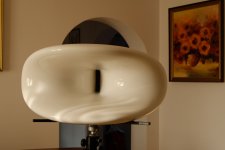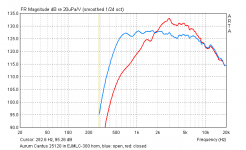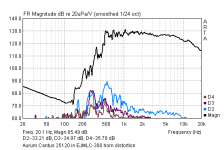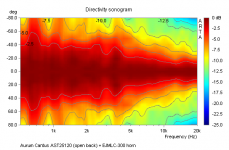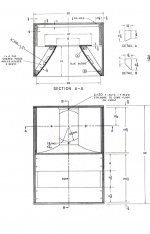I am usually not worried about whether other people can hear a difference unless unless I can. It is like if one were blind, there is know way one could understand what others see.
I am never worried about someone saying they hear a difference if I can't measure one.
Member
Joined 2009
Paid Member
For those interested - 300Hz horn for AMT with open and closed back.
that horn, looks the kind of thing to scare young children - or maybe I saw too many 1950's monster sci-fi movies
that horn, looks the kind of thing to scare young children - or maybe I saw too many 1950's monster sci-fi movies
YouTube
..and I sometimes "worry" that people doing the measuring couldn't identify any given difference even with that measurement (result) actually incorporating a difference.
This is the art of measurement - correlating a physical cause with a particular aberration. Also correlating a level of perception with the same aberration. One should do both. Its rare that anyone does either.
Distortion and polar. Aurum Cantus AST25120 is affordable.
Hi jzagaja,
is it possible THD <= -60dB
regards
ivica
A quick question for "jzagaja": Is the "J-Horn" on your webpage <J-HORN - Horns by Auto-Tech> similar to the short horn in an Altec A7 or A5? The dimensions look roughly similar.
Attachments
Radian 5215B Coaxial with Berrylium diaphragm looks really good in the freq response.
5215B Coaxial Speaker - Radian Audio
Can do 12db/oct at 1Khz with that compression driver. Perhaps 36db/oct on the woofer, Like the TAD monitor?
5215B Coaxial Speaker - Radian Audio
Can do 12db/oct at 1Khz with that compression driver. Perhaps 36db/oct on the woofer, Like the TAD monitor?
Uniformity off-axis isn't good for that Radian coax.. (as shown)
-part of this is expected in relation to the compression driver exit vs. the cone/horn expansion: with the result being a LOT of higher freq. treble loss. You can counter this subjectively with a reward facing tweeter (..bipolar super-tweeter).
-the other part is pretty much a function of the crossover. They don't have the crossover low enough in freq., nor a steep enough filter. That pressure drop around 1.4 kHz is not good as a result (..though it may be subjectively preferable given how a LOT of people like 2-ways with the same sort of problem). Of course you'd still need to create a filter with just the right amount of delay for the compression driver relative to the woofer when dropping the crossover freq.. The compression driver should be able to handle the lower freq. crossover as long as you don't expect really high output.
-part of this is expected in relation to the compression driver exit vs. the cone/horn expansion: with the result being a LOT of higher freq. treble loss. You can counter this subjectively with a reward facing tweeter (..bipolar super-tweeter).
-the other part is pretty much a function of the crossover. They don't have the crossover low enough in freq., nor a steep enough filter. That pressure drop around 1.4 kHz is not good as a result (..though it may be subjectively preferable given how a LOT of people like 2-ways with the same sort of problem). Of course you'd still need to create a filter with just the right amount of delay for the compression driver relative to the woofer when dropping the crossover freq.. The compression driver should be able to handle the lower freq. crossover as long as you don't expect really high output.
Looking at the 12", 15" coaxial designs, such as Radian and Tannoys -- what is preventing the manufacturers from using the ideal tweeter horn profile to make the woofer cone profile and using a large format compression driver to reach a 1khz crossover point?
Say like the 15" Tannoy with a 3" Berrylium compression tweeter, crossing over at 1khz...
I must be missing something because the woofer cone can be made based on the E-OS-15 waveguide, no?
Say like the 15" Tannoy with a 3" Berrylium compression tweeter, crossing over at 1khz...
I must be missing something because the woofer cone can be made based on the E-OS-15 waveguide, no?
There will never be an ideal profile.. BUT there can be a "better" profile for the cone near an intended crossover freq..
The 5215B (Radian) looks like it's just a straight profile, which probably isn't going to work great in this respect (..at least at this diameter). This reacts more strongly with the surround, resulting in that "dip" near 1 kHz along with a continuation near the average on-axis, but with a crap response off-axis.
IF the cone was contoured more the compression driver would loose that fixed ("constant") pressure-loss off-axis, but it could result in a much smoother response off-axis for the cone driver.
In this thread you can see a driver like this:
The umpteenth large format coaxial driver thread
You can actually see its profile here (along with its directivity plots):
B&C 15FCX76 is a 15" coaxial speaker - B&C 15FCX76 15" coaxial speakers - B&C 15" high power coaxial speaker for fullrange systems. B&C 15FCX76 coaxial speakers available now.
The price you are paying here for a cone like this is narrow-band linearity, with a "hash" effect at the top of the cone driver's passband. Basically instead of one substantial "resonance" as seen in the straight profile cone from Radian (..its largely an effect of the surround), you get a multitude of "resonances". What we would call "under-damped".
The 5215B (Radian) looks like it's just a straight profile, which probably isn't going to work great in this respect (..at least at this diameter). This reacts more strongly with the surround, resulting in that "dip" near 1 kHz along with a continuation near the average on-axis, but with a crap response off-axis.
IF the cone was contoured more the compression driver would loose that fixed ("constant") pressure-loss off-axis, but it could result in a much smoother response off-axis for the cone driver.
In this thread you can see a driver like this:
The umpteenth large format coaxial driver thread
You can actually see its profile here (along with its directivity plots):
B&C 15FCX76 is a 15" coaxial speaker - B&C 15FCX76 15" coaxial speakers - B&C 15" high power coaxial speaker for fullrange systems. B&C 15FCX76 coaxial speakers available now.
The price you are paying here for a cone like this is narrow-band linearity, with a "hash" effect at the top of the cone driver's passband. Basically instead of one substantial "resonance" as seen in the straight profile cone from Radian (..its largely an effect of the surround), you get a multitude of "resonances". What we would call "under-damped".
Last edited:
I'm thinking something like a 12" tannoy but with a large format berrylium compression driver would provide a good crossover transition -- where the 1khz crossover would be possible. Also with less of "hash" effect than a 15" coax.
Although I'm interested why the B&C 12FCX76 freq resp is uglier than the 15" version of the same driver...
The baffle needs to continue a slight flare transition like this, no?
8351 SAM™ Studio Monitor | Genelec.com
Although I'm interested why the B&C 12FCX76 freq resp is uglier than the 15" version of the same driver...
The baffle needs to continue a slight flare transition like this, no?
8351 SAM™ Studio Monitor | Genelec.com
If you want to lower the freq. of the "waveguide", then the baffle flare could be useful..
BUT
Unless it's really large, it won't drop the freq. much for directivity control.
12" tannoy + Be driver. Don't know of such a thing.
-I'd personally be looking at a Unity design for this sort of thing (..directivity control in the mid.s through the treble region).
BUT
Unless it's really large, it won't drop the freq. much for directivity control.
12" tannoy + Be driver. Don't know of such a thing.
-I'd personally be looking at a Unity design for this sort of thing (..directivity control in the mid.s through the treble region).
No, hopefully not - or - in this sense - you can close the forum
"If you've done six impossible things this morning, why not round it off with breakfast at Milliways, the Restaurant at the End of the Universe."
Milliways | Hitchhikers | FANDOM powered by Wikia
One of the six impossible things?
Cheers,
Mike
- Home
- Loudspeakers
- Multi-Way
- Beyond the Ariel
